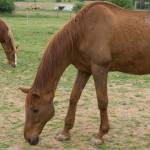Preventing Laminitis in Horses

If your horse has hooves, it’s at risk of developing laminitis, a painful inflammation and separation of the sensitive tissues that connect the inside of the hoof to the coffin bone. If you’ve suffered alongside a laminitic horse, you probably realize that time is of the essence. In many cases, prompt treatment maximizes the chances of a positive outcome. But according to a recent study*, only about half of horse owners can correctly identify laminitis in their horses.
In that study, a veterinary surgeon in the United Kingdom diagnosed 93 horses with laminitis. Fifty-one of those horses’ owners had suspected their steeds were suffering from laminitis and were indeed correct. On the other hand, owners of the remaining 42 horses believed their animals were suffering from an alternate cause of lameness, such as an abscess, bruised sole, navicular disease, or musculoskeletal stiffness. A few owners even thought their horses were suffering from an episode of colic.
The researchers noted that “failure of laminitis recognition by owners highlights further need for evidence-based education to ensure early disease detection.” In turn, early detection of laminitis horses permits prompt intervention to potentially decrease the severity and duration of disease.
Kathleen Crandell, Ph.D., a nutritionist with Kentucky Equine Research (KER), reminds horse owners, “Proper nutrition aimed at preventing problems in the feet and maintaining an appropriate body condition score are two important ways owners can help minimize the development of laminitis.”
She adds, “KER offers Bio-Bloom PS (Bio-Bloom HF in Australia), a nutritional supplement containing key nutrients for hoof health.” Notably, Bio•Bloom PS contains biotin, methionine, iodine, and chelated zinc to improve hoof growth and strength.
As an aside, the research team also documented that horse owners familiar with the clinical signs of laminitis often institute treatment without veterinary intervention. Lack of veterinary involvement when managing laminitic horses could result in the failure to recognize underlying causes, such as Cushing’s disease or insulin dysregulation, or failure to appreciate the severity of the disease. Always have your horse examined by a veterinarian if any change in your horse’s condition develops.
Nutrition advisors are available at KER to help you formulate a hoof-healthy diet. Click now to begin. Do you have another question about your horse’s diet? No problem. Start the discussion now!
*Pollard, D., C.E. Wylie, K.L.P. Verheyen, et al. Assessment of horse owners’ ability to recognise equine laminitis: a cross-sectional study of 93 veterinary diagnosed cases in Great Britain. Equine Veterinary Journal. In press.








